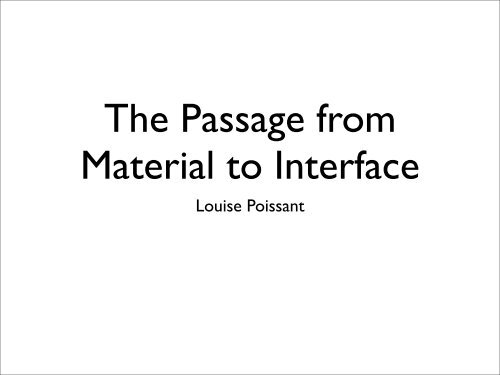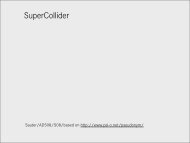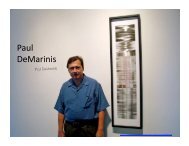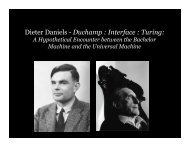Louise Poissant - Daniel Sauter
Louise Poissant - Daniel Sauter
Louise Poissant - Daniel Sauter
You also want an ePaper? Increase the reach of your titles
YUMPU automatically turns print PDFs into web optimized ePapers that Google loves.
The Passage from<br />
Material to Interface<br />
<strong>Louise</strong> <strong>Poissant</strong>
Henri Focillon “Now the artist develops, under our eyes,<br />
the very technique of the mind; he gives us a kind of<br />
mold or cast which we can both see and touch.“<br />
Suggests the creation of cartography of classical art history (including drift - past, present, future)
Declared carriers of social and genetic determinism, as<br />
noted at the beginning of the twentieth century, modern<br />
human beings put themselves to the test by assuming their<br />
future and thus investing in a program for change.
Poles of art:<br />
1) artistsʼ commitment became one of representing their vision of the<br />
world, their emotions, offering a picture of reality, exalting a spiritual,<br />
political value, etc.<br />
2) Work on the material of an artwork can also reveal changes in the<br />
distribution of diverse roles, in which the artists feel invested as:<br />
visionary, creator, denunciator, consciousness-raiser, absorber of an<br />
eraʼs sensibility, partner in a process, etc.<br />
3) And finally, the new materials point to the reorganization of the<br />
relationship between artists and spectators aiming, for over a<br />
century, for an increased empowerment of the spectator, one who is<br />
now called upon to intervene in a determining way in the process of<br />
the creation of the artwork, as it has become the case in interactive<br />
artworks.
The message is the not only the medium but modality<br />
References:<br />
Frank Hopper<br />
“the decline of the object”<br />
Isabelle Rieusset-Lemarié<br />
“The technique is an interactive mirror”<br />
Marshall McLuhan<br />
“We shape our tools and afterwards our tools shape us<br />
The message shapes the messenger
all point pen first disposable object
the russians used a pencil
The intellectual climate<br />
Material to medium to interface<br />
Wittgenstein “meaning is use”
J.L. Austin came to the conclusion that every utterance has a performative<br />
dimension, and he proposed five categories: verdictives, exercitives,<br />
commissives, behabitives, expositives.<br />
Charles Morris “the pragmatic dimension of language by emphasizing the<br />
relation between signs and interpreters.”<br />
Implicity = the interaction between partners in a communicational exchange.
Francoise Armengeaud<br />
• The concept of the act: to speak is not only to represent,<br />
it is also to act upon others. Thus the notion of interaction,<br />
of transaction.<br />
• The concept of context: the concrete situation where<br />
words are uttered (the place, the time, the interlocutorʼs<br />
identity) and can influence the exchange<br />
• The concept of performance, that is, the accomplishment<br />
of an act in a context, which allows the actualization of<br />
competences.
Umberto Eco “interpretative process”<br />
represents<br />
and “individual<br />
and tacit<br />
form of execution of the artwork”<br />
Marc Lebot “Art communicates nothing to me”<br />
pragmatism emphasizes the creation of meaning through<br />
the single act of an exchange with the other,<br />
renouncing the disclosure of privileged meaning<br />
which the artists would have instilled into their artwork.
Interactivity in new media art<br />
Also a few considerations are essential to the determinant<br />
notion of interactivity in new media art. Interactivity in arts,<br />
can be traced back to the 1960ʼs -- though not in French<br />
until 1980. It is now banal and outdated.<br />
Computer to human computing = anterior<br />
Agents of connection are needed for the<br />
passage from material to interface
The forerunners of art<br />
1909 Futurists Bruno Corra and Arnaldo Ginna stage=designed a<br />
projection<br />
1920 Scriabin production of Prometheus<br />
These experiences deserve attention because therein one finds the<br />
seed of many elements to be later developed in new media arts.<br />
1959 Allan Kaprow initiated a series of happenings<br />
Augusto Boal, first to coin the term spect-actor<br />
1963 Nam Jun Paik - participation tv<br />
Video environments of Lee Levine, Bruce Nauman, and Peter<br />
Campus<br />
1967 Raduz Cincera interactive video projections
Signed the 11 September 1916 from Marinetti, Brown Run, Arnaldo Gins, Giacomo Dances, Remus<br />
Chiti and Emilio Settimelli, the obvious one The futuristic Cinematography greeted, after initial<br />
perplexity aside of Boccioni, the expressive novelty means that, if "futuristicly" interpreted, came seen<br />
like "cheerful deformation dell' universe [..] the better school for the boys: school of delight, of<br />
speed, of force, of recklessness and of heroism". After the proposals of revival of the theater, the<br />
cinema, "theater without words", expressive means modern (but until then "traditionalist", rhetorical<br />
in the performance, traditional in the stages and in the customs), autonomous, capable of to<br />
accelerate or to slow down the motion, to blend times and places being at a distance, intervening sull'<br />
objective appearance of the things, became so "the most suitable means of expression to the<br />
plurisensibilità of a futuristic artist". L' suction to an entire separation of the cinema from the reality,<br />
to become "antigrazioso, deformatore, impressionist, synthetic, dynamic, parolibero", it is translated in<br />
the practice, still before the publication of the obvious one, in irreverent solutions and news (film that<br />
exclude the human body telling a story across the shots of the only feet, I use of mirrors distorting...
Martha Argerich plays Scriabin's "Prométhée,<br />
le poème du feu" Op. 60 (Symphony No. 5),<br />
with Claudio Abbado, Berliner Philharmoniker<br />
and Berliner Singakademie<br />
Berlin - May 23/25, 1992
Allan Kaprow, Maneuvers (1976/2007), Version by Sybill Häus
Installation view of Peter<br />
Campus's Interface at<br />
Kolnischer Kunstverein<br />
(1972)<br />
Copyright the artist
Kino-Automat<br />
Raduz Cincera, 1967<br />
Links<br />
http://naid.sppsr.ucla.edu<br />
Speaking with the Artist<br />
http://www.naimark.net<br />
Billed as "the world's first interactive movie," Kino-Automat was shown in a specially-built theater in the Czech Pavillion at Expo '67 in Montreal. Each of the 127 seats in the theater had a pushbutton panel with one<br />
red and one green button. Five times during the movie, the show stops and a live performer appears on stage and asks the audience to vote on which of two possible scenes should play next. Everyone's vote is<br />
visible around the perimeter of the film screen. As if by magic, the voted scene is played.<br />
It's not magic but clever design: rather than creating an exponential branching structure requiring many possible scenes, Cincera wrote the script such that each scene ends back at the same next option,<br />
regardless of which was chosen.In fact, the "magic" was really a projectionist switching the lens cap between two sychronized projectors based on the voting results.<br />
It's important to note that there is no "new media" technology used for Kino-Automat. Yet it's one of the first known examples of "interactive media" of any kind and is therefore relevant.<br />
Cincera made Kino-Automat as a politically-inspired joke. The opening scene is of Mr. Novak, the main character, in front of a burn-down apartment building saying "it wasn't my fault, really. Let me tell you my<br />
story." Thus the initial set-up is that the story is a flashback with a pre-determined ending. After some of the choices, Mr. Novak appears onscreen again and say to the audience "That's an excellent choice. I'm glad<br />
you made that choice, and I don't say this often!" Cincera, a Czech during the Cold War, wanted to make a commentary on the illusion of control of voting.<br />
Kino-Automat inspired me, largely because it demontrates that in the end, the difference between actual control and apparent control, is zero.<br />
Submitted by<br />
Michael Naimark<br />
http://stage.itp.nyu.edu/history/timeline/kinoautomat.html
If these works only allowed a limited role, for<br />
example cranking a handle or finding oneself<br />
included in the artwork against oneʼs will, one<br />
understands these to be the very first steps toward<br />
a more complex interactivity, inviting more creative<br />
interaction.<br />
interaction is slowly shifting toward a more refined<br />
notion of “alteraction”<br />
puts emphasis on not only the action but also on the<br />
encounter with the other. Reynald Drouhin<br />
many incorporate it into their work without naming it.
levels of interactivity exist - we arrive at the instrument<br />
that allows by means of feedback, to measure reality -<br />
foreseen by Gilbert Simondon<br />
we are now entering the era of the interface. allowing<br />
users or spectators to feel part of the process.<br />
is it the democratization of the number of spectators<br />
that can actively participate in interface<br />
New media arts create environments where it is<br />
allowed to surpass instrumentality and to explore other<br />
behaviors and ways of connecting with each other.
The Interfaces: Shifters<br />
In the context of new media arts where it is the intention to convert the<br />
spectators into actors, one understands that a goo part of the operation must<br />
be made through interfaces, devices that link humans to machines.<br />
interface becomes conductor that participates in the production of an artwork<br />
oneʼs interest in questioning interfaces inscribes itself in the fact that they<br />
condense themselves to the state of knowledge, know-how, and creativity at<br />
play; the degree of openness with regard to chance (this is a position john<br />
cage advocated) to the others and to the environment; to methods of control.
Six principle categories of conductor<br />
interfaces in new media arts:<br />
1) sensors: microphones, datagloves, photovoltaic<br />
sheets, ultrasound detectors (perception)<br />
2) recorders: photo camera, mechanical phonograph,<br />
digital memory (sample of reality)<br />
3) actuators: pneumatic, hydraulic, electric devices in<br />
robotics (movement)<br />
4) transmitters: telegraph, internet, performances by<br />
telepresence (abolition of distance)<br />
5) diffusers: magic lantern, interactive hd tv, barrel organ,<br />
digital acoustics (a/v broadcasting)<br />
6) integrators: automation, cyborgs (reproduce the living)
Each of these interfaces allows the<br />
articulation of a particular form of<br />
interactivity and the investing of the<br />
receptors as partners... Some of them join<br />
or contribute to an aesthetic and cultural<br />
paradigm shift.
Five Functions<br />
extendible, revealing, rehabilitating, filtering, or the agent of<br />
synthesthetic integration<br />
not exclusive and frequently fulfilling more than one. their<br />
essential role consists in carrying out smooth mediations<br />
between thought and matter, thought and sensibility.
Conclusion<br />
disappointing experiments = over promise/under<br />
deliver<br />
danger of maintaining the illusion of advancing<br />
art was meant to be thought about and not felt, or<br />
to be felt through the many detours of<br />
intellectualization
Class thoughts<br />
Arunan talks about - the subtleties of natural interactivity - possibly rethinking<br />
impressionism through the lens of new media arts<br />
Joe talks about - it just becoming a dialog looped through a machine and<br />
brought back to the viewer - erasure of the artist<br />
Julio talks about - participation does not only come from interaction.<br />
Jesus had two questions - In the context of using art as communication is<br />
our aim simply to establish the best communication possible by abstracting<br />
to the point where the participants in the communique end up one in the<br />
same The viewers become an extension of ourselves potentially as a<br />
perfect feedback system<br />
Alejandro quotes <strong>Poissant</strong> with questions embedded “In interface<br />
experiences that put interactivity into play the complicity (really) of the<br />
alteractor (what) is required by the dialogical artwork (what is a dialogical<br />
artwork) to take place.”
Class thoughts<br />
J.D. talks about - (image to the right) As<br />
early as the 15th century, artists and<br />
inventors began experimenting with this<br />
level of interactivity—have we come<br />
much farther in our conceptual thinking<br />
Chaz talks about - you find individual<br />
moments and phrases that are<br />
beautifully and insightfully turned, yet<br />
they donʼt add to a more concise or<br />
specific thesis. Everything keeps going<br />
back to a grand and general theme.<br />
Brittany talks about - The examination of<br />
the interfaces used in these instances<br />
must take into account the ergonomic<br />
complex including the users (in my<br />
personal case insects or animals), their<br />
degree of sensibility (do they even have<br />
a degree of sensibility), and the context<br />
of the use as well as its functionality (to<br />
communicate their behavior to humans)
Questions<br />
What do you think of <strong>Poissant</strong> saying art was meant to<br />
be thought about and not felt, or to be felt through the<br />
many detours of intellectualization<br />
How does this relate to your study in 508<br />
How does it relate to one of your classmates work



![the coming age of calm technology[1] - Daniel Sauter](https://img.yumpu.com/47923551/1/184x260/the-coming-age-of-calm-technology1-daniel-sauter.jpg?quality=85)






